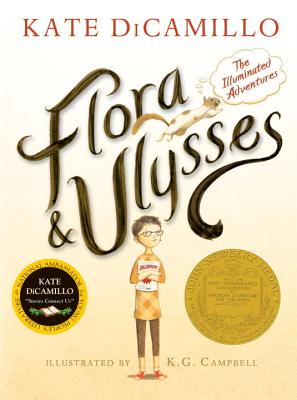craft review by Kristi Wright

Flora and Ulysses, by Kate DiCamillo, Illustrated by K.G. Campbell (Candlewick, 2013)
There are a myriad of things that Kate DiCamillo does brilliantly as a writer—let’s face it, she didn’t win two Newbery Medals for nothing—but with FLORA & ULYSSES, I’m going to focus on her marvelous command of character and situations to write laugh-out-loud comedy.
FLORA & ULYSSES is a buddy story about a young girl who insists she is a natural-born cynic and the unassuming squirrel who becomes a superhero through a near-death experience. Together they discover friendship, hope, and love. Publisher Candlewick dubbed Flora & Ulysses “genre-bending” because it features a split narrative format incorporating graphic and comics-style layouts and illustrations. The graphics by K. G. Campbell are delightful and add much to the humor as well.
I recently came across an excellent blog post on comedic writing from Mark Kennedy. In it, he makes the point that “the biggest laughs always come from watching characters react, think and take action.” As a writer you have to know your characters so well that you “see the world through their eyes – no matter how outlandish or crazy the situation.”
DiCamillo is a master when it comes to creating interesting characters and situations for them to react to that allow for these wonderfully comedic moments.
Humor Driven by a Character’s Unique Way of Thinking
Take the main character, Flora, for instance. Flora says she is a natural-born cynic and yet she is obsessed with a superhero comic series from which she has gleaned that impossible things happen all the time. While Flora says and thinks cynical things and typically assumes the worst from others and from the world, her actions show that she wants to believe in impossible things (like superheroes), that she is a hopeful, heroic, and helpful person.
At the opening of the story, Flora sees her neighbor vacuum up a squirrel by accident. If Flora had been a true cynic, she likely would have felt a momentary sadness and closed her curtains. That would not have been funny. Instead, Flora goes into comic book mode. She says, “This malfeasance must be stopped,” because that’s what the superhero in her favorite series says. Then she surprises herself by running to the squirrel’s aid. In fact, Flora gives the squirrel mouth-to-mouth resuscitation!
The situation of a runaway vacuum that sucks up a squirrel is only funny because DiCamillo has created a character who has no other choice but to engage in a humorous (and humanitarian) way.
Another similar example, comes in the beginning of Chapter 21 when Flora uses her comic book knowledge to provide first aid, this time to a human:
“Tootie was on the couch with a package of frozen peas on her head. She had fainted.
Unfortunately, she had hit her head on the edge of the desk on the way down.
Fortunately, Flora had remembered an issue of TERRIBLE THINGS CAN HAPPEN TO YOU advising that a bag of frozen peas made an excellent cold compress to ‘provide comfort and reduce swelling.'”
Again, there is nothing particularly funny about someone fainting, but Flora’s unique way of dealing with it is funny.
Action: Look for opportunities in your own writing to amp up the humor by committing to your character’s unique thought process and reactions no matter how outlandish they might seem.
Humor Driven by a Character’s Physical Trait
A particularly funny moment in Flora & Ulysses takes place in a diner. DiCamillo sets up the situation when she introduces a new character, a waitress named Rita who has hair piled up “very, very high on her head,” which makes her look like Marie Antoinette.
She then has the waitress insist on seeing what Flora has in her shoebox. When she pokes her pencil into the box, she finds Ulysses.
She screamed; he screamed.
And then every one of his animal instincts kicked in. He acted without thinking. He tried to escape. He leaped from the box and ended up, somehow, exactly where he did not want to be: in the middle of the monstrous hair.
Rita jumped up and down. She put her hands to her head. She swatted and clawed, trying to dislodge him. The harder she hit him, the higher she jumped, the more fiercely the squirrel clung.
In this way, Rita and Ulysses danced together around the Giant Do-Nut.
This situation would have been funny even without the hair setup, but knowing that the waitress had Marie Antoinette hair increases the comedic impact. In fact, from the moment that the reader hears about the waitress and her mound of hair, it’s likely that they are anticipating the wonderful moment when Ulysses ends up tangled in it.
Action: Brainstorm situations that have comedic potential then use your character’s physical or personality traits to set up for maximum hilarity.
What moments in FLORA & ULYSSES made you laugh out loud, and why?
Kristi Wright (co-editor) writes picture books and middle grade novels. Her goal as a writer is to give children a sense of wonder, a hopefulness about humanity, and a belief in their future. She is represented by Kurestin Armada at Root Literary. She is an active volunteer for SCBWI and a 12 X 12 member. Find her at www.kristiwrightauthor.com and on Twitter @KristiWrite.


Such a great post about why the humor works. Now I want to go back and read the book a third time!
I love the scene in the diner! That hair! I hadn’t thought about why the scene was funny.
I love the image in the final line: “they danced together around the Giant Do-Nut.” That verb “danced” adds a certain light humor at the end by pulling back the camera and using a surprising verb.
[…] just finished Flora and Ulysses [ed: see our review here]. I loved the portrayal of unique and well-defined characters that drove the plot relentlessly […]
I similarly adore DiCamillo’s sense of humor. So many elements of Flora and Ulysses were funny to me. Let me rattle off a few!
Flora’s mother’s obsession with the shepherdess lamp.
Her father’s way of introducing himself over and over again.
Dr. Meechum’s horsehair sofa and how Flora slides off of it.
The names of the comics, Terrible Things Can Happen to You and The Criminal Element is Among Us…just so totally dark for a youngster and yet…it works.
Seal blubber.
How Flora is in her jammies for almost the whole book.
How Rita’s nametag has an exclamation point RITA!
I truly could go on and on. This is one of my favorites. I like DiCamillo’s humorous books more than her sad ones 🙂
Hi Sara:
Yes, this was one of my favorite DiCamillos too! So many great scenes and details. I love your list. I’m definitely going to have to re-read it now! I wrote this blog post quite a few years ago and I’m realizing that there are so many wonderful scenes and details I need to enjoy anew! Thank you so much for commenting:) DiCamillo is the master when it comes to humor:)
Best, Kristi